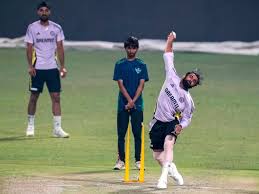The much-anticipated return of Mohammed Shami to international cricket was expected to take center stage during the India vs England 1st T20I at Eden Gardens, Kolkata. This match was to mark Shami’s comeback after a 14-month hiatus from international cricket, with his last outing being the 2023 ODI World Cup final in November. His last T20I appearance dated back to the T20 World Cup in Australia in 2022. With Jasprit Bumrah’s fitness under scrutiny, Shami’s presence in the Indian squad was seen as a crucial step in preparing him for the upcoming ICC Champions Trophy.

However, as the toss concluded and the playing XI was announced, Shami’s name was notably absent. India opted for just one specialist fast bowler, Arshdeep Singh, supported by seam-bowling all-rounders Hardik Pandya and Nitish Kumar Reddy. England, on the other hand, fielded four frontline pacers. Shami’s exclusion raised questions: Was he unfit? Or was this a tactical move by the Indian team management?
Fitness Concerns or Tactical Decision?
Former Indian cricketer Aakash Chopra speculated that Shami might not have been fully fit, stating on social media:
“Shami not playing. Obviously not 100% fit for today. India has chosen to play only one frontline pacer in Arshdeep. Hardik-Nitish the two other pace options. England fielded 4 proper pacers. Both captains seeing the pitch differently.”
While this theory gained traction, Shami’s presence during the warm-ups told a different story. The 34-year-old bowled in the nets and did not appear to be in visible discomfort, despite heavy strapping on his left knee. He bowled with intensity in training sessions leading up to the game, raising doubts about whether fitness was the primary reason for his exclusion.
Suryakumar Yadav’s Explanation
Indian skipper Suryakumar Yadav clarified the decision in the post-match interview, revealing it was a tactical move. “We wanted to stick to our strengths,” he said. On a pitch offering more assistance to spinners, the Indian management chose to field three specialist spinners—Varun Chakaravarthy, Ravi Bishnoi, and Axar Patel—along with Arshdeep Singh.
Abhishek Sharma, who played a pivotal role with a blistering 79 off 34 balls, also backed the team management’s decision. “It’s the call of the management based on the conditions,” he said in the post-match press conference.
The Gambhir Influence: A Masterstroke Against Bazball
India’s revamped T20 approach has been heavily influenced by Gautam Gambhir, who has prioritized role-specific selections over star power. Not playing a bowler of Shami’s caliber may have seemed bold, but it was a calculated move. The strategy to rely on spin against England’s aggressive ‘Bazball’ approach paid off spectacularly.
India’s spinners dominated, restricting England to just 67 runs while taking five wickets in 12 overs. With the exception of Jos Buttler, the English batters struggled against the Indian spin trio, proving the tactical call to bench Shami was spot-on.
Shami’s T20I Numbers and the Bigger Picture
Despite being one of India’s premier pacers in Test and ODI formats, T20Is have not been Shami’s strongest suit. Over his 11-year international career, he has played 23 T20Is, taking 24 wickets at an economy rate nearing nine runs per over. Given this, Gambhir may have believed that Shami’s return on a pacer-friendly surface could have played into England’s hands.
Ironically, while Shami bowled extensively in the nets, his absence from the playing XI was confirmed during the toss. Although he seemed fit, the lingering effects of a swollen left knee after rigorous sessions may have influenced the management’s decision to rest him.
Conclusion
Ultimately, Shami’s exclusion from the first T20I boiled down to a mix of tactical planning and potential fitness considerations. The decision to prioritize spin over pace turned out to be a masterstroke, with India’s spinners proving too hot to handle for England. Whether Shami returns in the upcoming matches or is preserved for the Champions Trophy remains to be seen, but this game showcased India’s ability to adapt and innovate based on conditions.


